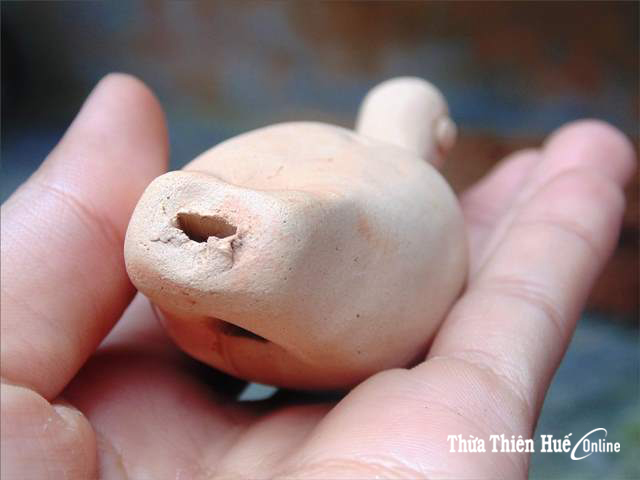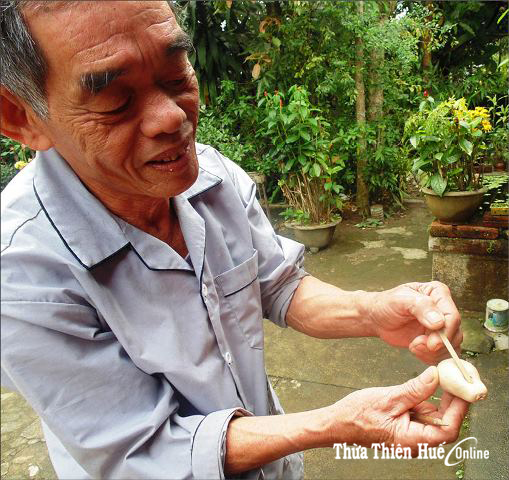
Clear sounds of tu huyt whistles depend on how holes were made
1. With more than 500 years of existence, the pottery village is still quiet and calm with very few laughters of children and no sounds of welders, cutters, and file machinery. Now and then, what can be heard is the sounds of tu huyt whistles from somewhere in the village. Many times when I dropped by this village, considered one of the most beautiful ancient villages in Vietnam, I listened to the sounds of tu huyt whistles and it made my heart feel affectionate. It recalled the time I sat with old people in the highland listening to clod, one of the traditional instruments of Co Tu minorities, and I visualize tu huyt, the sound of the atmosphere of village meetings and festivals.
The sounds of tu huyt whistles have long become the breath of life of the village. The elderly in Phuoc Tich say that in the past when villagers were poor, toys sold at the market were a luxury. While adults were busy with making pottery pots and kettles to keep up with the fired batch, children were free to roll over on the ground playing with tu huyt whistles as their dear friends.
In the old days, tu huyt whistles were regarded as toys for children and old people in the village. Children always brought with them some tu huyt whistles in their pockets. They gathered together and competed whistling with one another to find out who gave the longest, loudest and to compare the level of melody and delicacy from “the piece of earth that can speak”. By and by, the sounds of tu huyt becomes familiar and imprinted on the mind of each Phuoc Tich villager.
Watching Mr. Le Trong Dao (the owner of a ruong house - a house propped up by a system of wood pillars - in Phuoc Tich) performing with his tu huyt whistle, we could recognize the sounds being so melodious, peaceful and as modest as people in the village. It is a perfect combination between the blower’s breath and the soul of heaven and earth.
"Each tu huyt whistle has 2 to 3 holes. A hole for blowing, a hole for ventilation, usually below the whistle, and another extra small hole on top (for rhythms). There will be this small hole or not as the player pleases. The sound quality depends on the techniques the holes were made,” said Dao.
According to Nguyen The, a researcher on folk culture, everyone in the pottery kiln learns to make tu huyt whistles in the shape of a bird from a small piece of clay. Both adults and children in the village are good at making tu huyt, and consider them as the products of the children times. These products bear the distinctive characteristic of Phuoc Tich, as the echoes of the motherland.
We visited Luong Thanh Hien’s pottery kiln. He showed us some tu huyt whistles that he was working on. “So much work. I work on this turning table from morning till night, still, I could not supply enough products. Very few people in the village care about this work today; thus, it’s hard to find assistants” said Hien.

Mr. Le Trong Dao is blowing a tu huyt whistle
2. Phuoc Tich is considered a typical pottery village of Central Vietnam. The smell of earth and pottery is deeply imprinted in each villager. Though the forming of the folk games kneaded from pottery has gradually been forgotten, there remain some people who consider tu huyt whistle part of their memory.
Le Thi Minh Tam, a teacher living far away from home, always brings with her a tu huyt whistle kneaded in Phuoc Tich ancient village as her company in the hope that future generations of Phuoc Tich will not forget their native village.
“Phuoc Tich has its own characteristics that draw its natives back. Living far away from home, I always carry a tu huyt whistle to blow when I feel homesick. It is not only the sound of the homeland but also a product that goes along with the ancient village through time. To me, the tu huyt whistle is not only a souvenir but also the creative and developing process of the artisans in Phuoc Tich,” said Tam.
The name tu huyt comes from the sound it produces, a sound like the singing of the bird. That explains why this 5-century-old tuy huyt whistle is kneaded in the shape of a bird. Not everyone can knead a tu huyt that can produce sounds. While certain people knead a tu huyt whistle producing clear and elegant sounds, some do it with rude, discontinuous and unstable sounds. Worst of all, some knead tu huyt whistles which make no sounds at all.
To visitors to Phuoc Tich, the tu huyt whistle is a rustic gift, a souvenir presented to them by villagers. the sounds chiming from tu huyt are like the breath of the land and the stories of modest people in Phong Hoa.
Though tu huyt whistles are so familiar, they are now rather hard to find. Apart from Hien's pottery kiln, it’s hard to buy a tu huyt whistle as a present anywhere. “The sounds of tu huyt whistles have been so far imprinted deeply in Phuoc Tich people. However, today, along with other products, the tu huyt whistle is gradually being forgotten. Villagers and pottery artisans in Phuoc Tich are trying their best to improve the design so as to bring Phuoc Tich pottery products to the outside market; not only in the province but in many other provinces and cities as well.” said Mr. Luong Thanh Khieu, a member of the management board of Phuoc Tich ancient village.
Tu huyt is like the breath of the village. To conserve this rustic sound , artisans here are diversifying their products to meet the demand of people in modern times.
The rustic and humble tu huyt whistle becomes the product in display as to introduce the beginning till the flourishing time of the pottery career. It is not only a toy for inhabitants of a small pottery village but also as a witness to the development of the pottery village from the past to the present. This souvenir should be improved in design, for example, made in the shapes of the 12 year-animals designations, or with Phuoc Tich ancient village trademarks and logos included; so that when visitors choose the souvenirs for gifts, Phuoc Tich pottery is more widely known,” said Mr. Nguyen The, a folklore researcher.
Story and photos: Le Tho - Hai Linh